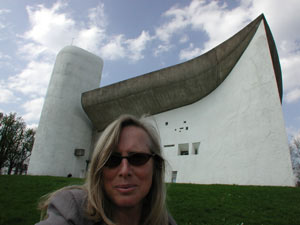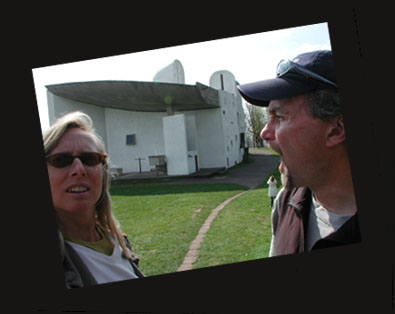
The Art Tourists Visit the LeCorbusier Chapel -- Notre Dame du Haut
by
Terry Talty
Ronchamp, France - The French like Jerry Lewis because he gives them behavior they can laugh at - it's silly. The French don't laugh at people who are trying to do something. George Bush? Yes, they do laugh at politicians, not for what they try to do, but if they aren't smart enough for the job. They would not laugh at an architect who tried something different, who made the Beaubourg - whether they like that structure they call the Pompidou Center or not.
So LeCorbusier could make a chapel completely out of concrete, a chapel that has the awkward lightness of the flying nun and the immense presence weightier than any tall glass tower.
A visit to this chapel, which is operated solely by private funds, is one of the best art deals in France at 3 Euro per adult visitor. Okay this isn't contemporary art, but it was contemporary architecture in 1955. It's a cool place. You start at the parking lot on the road from Ronchamp via a narrow little climb starting with a vehicular limbo maneuver under an ancient train bridge.
A few steps up from the car park visitors encounter the cheesey gift shop -- which also ofter highbrow copies of lectures about the chapel -- and then a trail up a steep hill to the meadow with the chapel. A white form peeks through the hills and bushes on the trail until its crest and the whole sculpture appears -- a sculpture that you can go inside.
The church is open with modern chairs set up to direct the faithful to the appropriate stage. Inside, the architect invited in the outside with various window shapes and left them mostly undecorated. Windows as conduit to the outdoors are often obscured in old cathedrals with a lot of incomprehensible imagery lined up tits to ass. Courbousier's slits and shapes of windows look like handmade glass with some lyrical colored words that gave them an appropriate amount of tradition to meet the needs of providing stained glass - the glow of sunlight, but yet letting it in as we see it naturally. The roof is lifted off the structure of the walls and light can come through in many places and is a floating sculpture above the person inside. It's concrete, too, cast onto wood boards so it has the visual/virtual texture of wood.

From this picture you can see the open-air altar, while we're looking off this knob at a beautiful rural, hilly countryside. There are all kinds of people striding around the grounds, taking in the piece like the only three-dimensional piece in a dedicated sculpture garden. Concrete just doesn't wear very well, my companion says. The wood texture still looks nice, but the smooth wall painted white probably looked a lot better fifty years ago. You can see why those guys in the 13th Century used stone. At this point my companion - a conceptual artist - pulls out a small flat model that gives the illusion it's a shipping crate. And he sets it up on the grounds and starts taking pictures of people looking at the sculpture - everyone, of course, is taking pictures so it's nothing unusual, but some observant French woman ask, 'what is that?² and we are absolutely stumped in all languages to describe it.
They looked as if they wondered if we were Jerry Lewis and about to do something funny, but I said, it was an art project and that my companion is an artist, and they did not laugh, they regarded the scene carefully. Later, we were decompressing from the awesome impact of - well the nerve of this guy to build such a weird thing -- sitting on the lawn around the parking lot and watching some more awestruck people walk down when a French guy said - well we've seen the Chapelle of Notre Dame du Haut - Our Lady of the High -- where's the chapel for Our Lady of the Low.